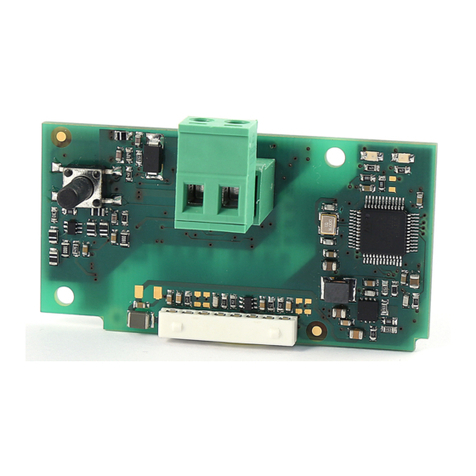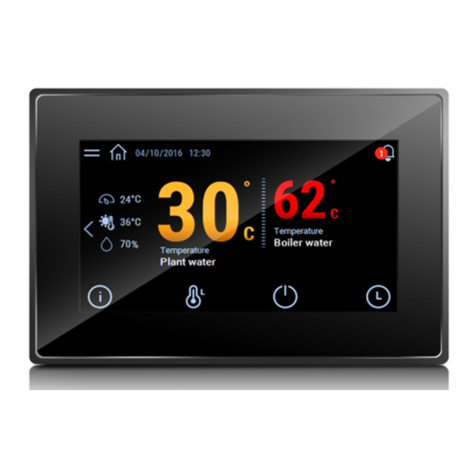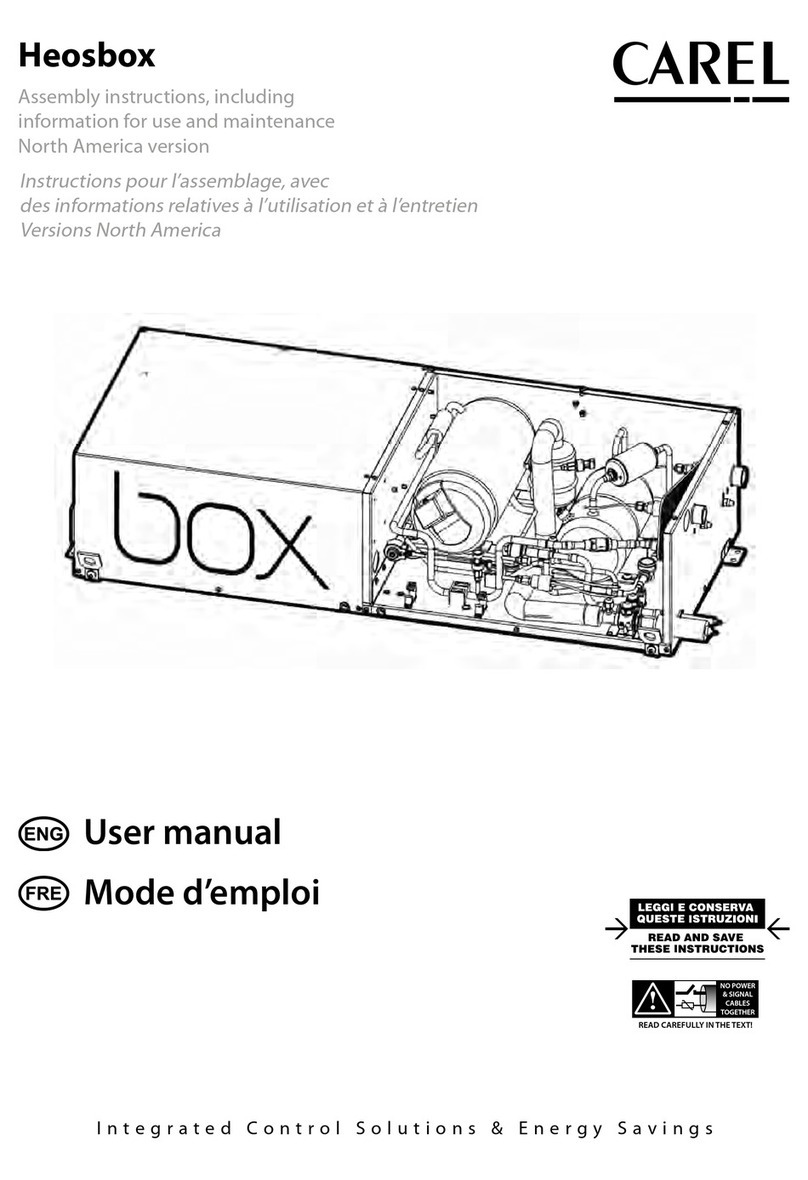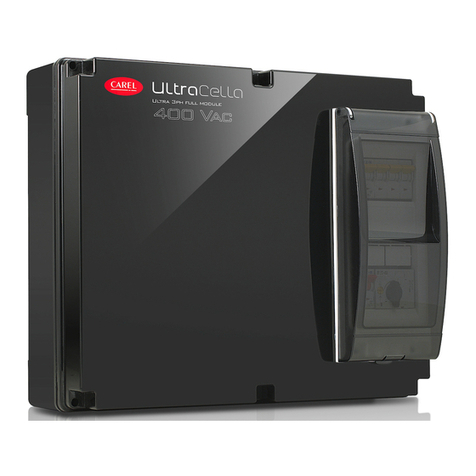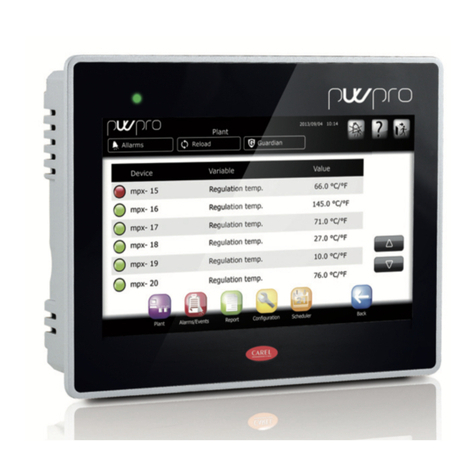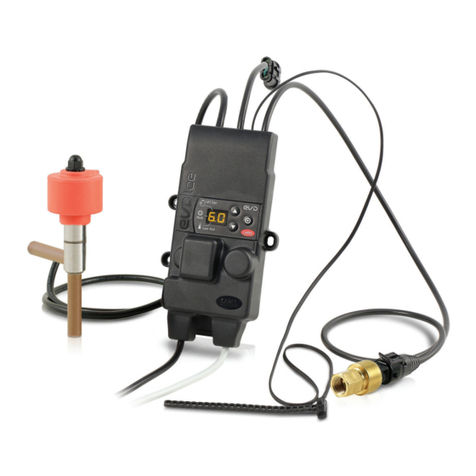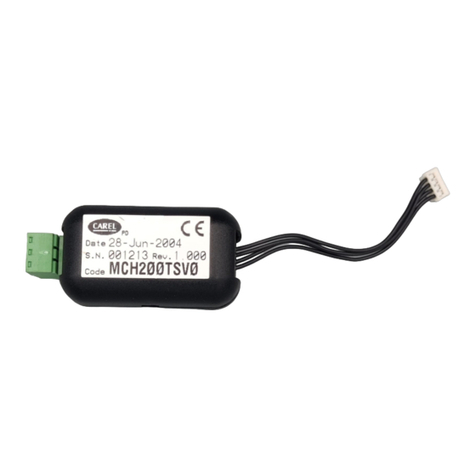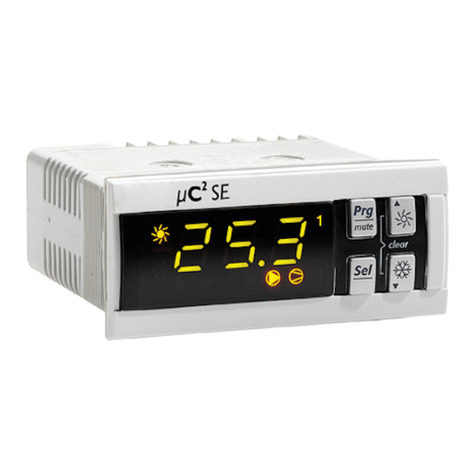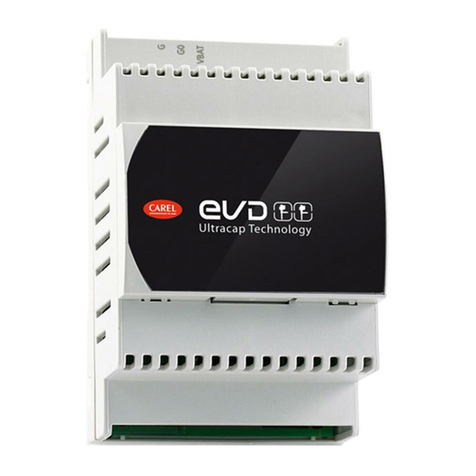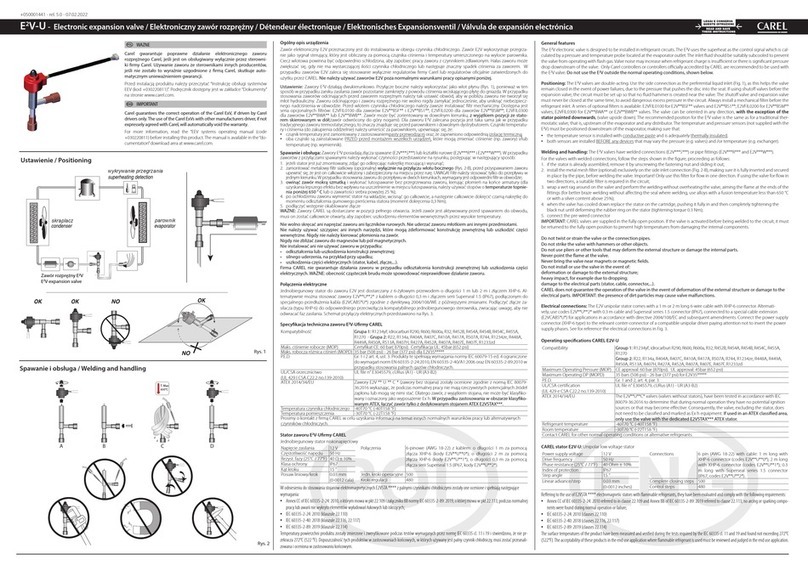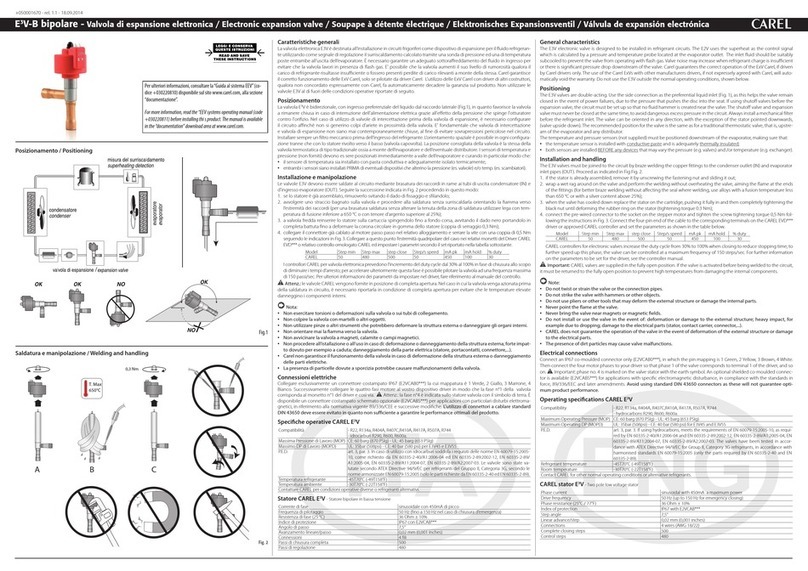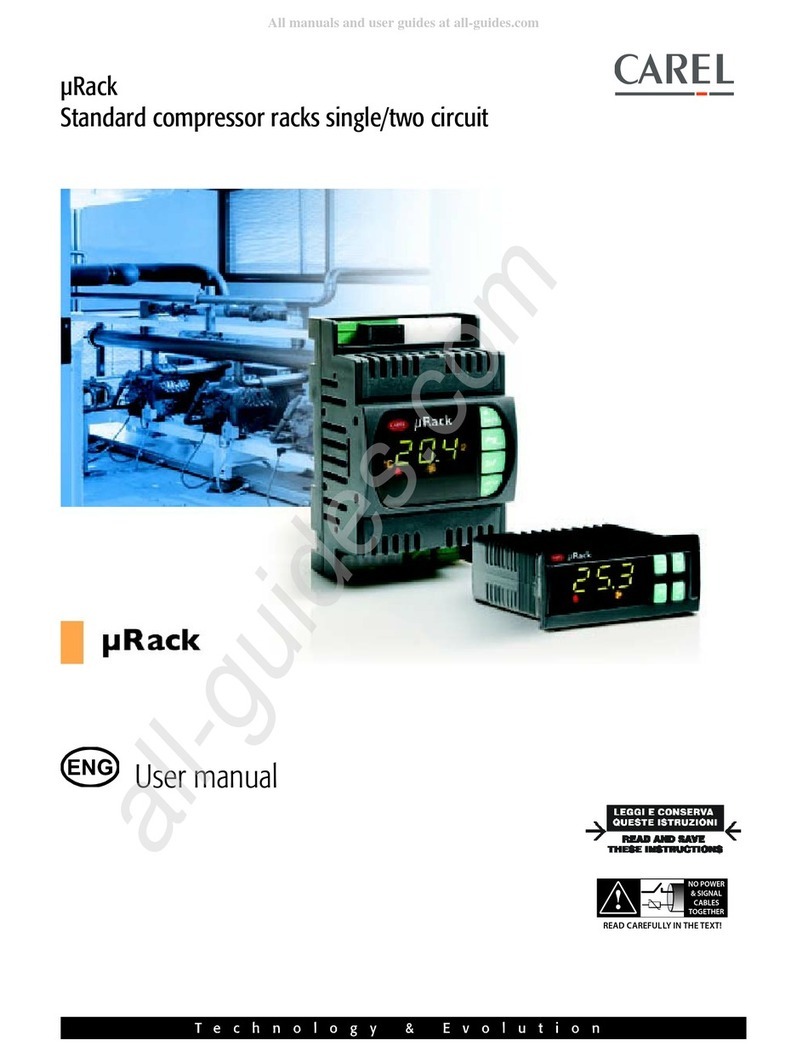
zz
+050001660 - rel. 1.4- 15.11.2016
E3V-C - 電子膨張弁 / Electronic expansion valve
Fig.1
OK
OK
NO
取付け位置 / Positioning
gasket
フィルター
ガスケット
filter
T.Max
700° C
60 Nm
3 mm
AB C
ねじ込み
First step tightening
(手動 / manually)
D
締付け
Second step tightening
(スパナで / with key)
E
溶接時の注意 / Welding and handling
General features
The E3V-C electronic valve is used as the pressure controller in transcritical circuits with CO2 refrigerant (R744). Only CAREL
control devices should be used to manage the E3V-C. Do not use the E3V-C valves outside of the normal operating conditions,
shown below.
Positioning
The E3V-C valve is single-acting, with the fluid entering through the side connection (Fig. 1). If using shutoff valves before the
expansion valve, the circuit must be set up so that no fluid hammer is created near the valve.
The shutoff valve and expansion valve must never be closed at the same time, to avoid dangerous excess pressure in the circuit.
Always install the mechanical filter supplied.
The valve can be oriented in any direction, with the exception of the stator pointed downwards (valve upside down).
Welding and handling
The E3V-C valves must be welded to the circuit in the correct direction of flow.
Follow the steps shown in Fig. 2, proceeding as follows:
1. Take the valve from the packaging.
2. If assembled, disassemble the valve body and the cartridge.
3. Wrap a wet rag around the valve and braze without overheating the valve, aiming the flame at the ends of the fittings. Use alloys with
a fusion temperature less than 700° C. If welded using other methods, do not exceed 100° C on the valve body. Avoid leaving solid
residues inside the valve body; it is recommended to flux with a suitable shielding gas.
4. Make sure that the cartridge O-ring is present and in position (Fig. 2-B).
5. Make sure that the metal mesh filter supplied is inserted on the cartridge (Fig. 2-B). Otherwise, position it as shown in the figure,
making sure it is fully inserted.
6. First step tightening (by hand). Screw the cartridge in the threaded valve body; do this operation manually up to 3 mm from
the assembly (Fig. 2.c.). Attention! To this height, the manual installation should be easy; otherwise, the shutter may not be
properly inserted in the orifice.
7. Second step tightening (with key). Tighten the cartridge on the valve body with a torque of 60 Nm suggested using a wrench
32 (Fig. 2.d). Attention! In the case of the shutter is not properly inserted in the orifice, the final tightening may damage the
cartridge.
8. To allow faster valve assembly, it is recommended not to remove the motor from the cartridge. If removing and reassembling the
motor, make sure that the red stator is fully inserted in the cartridge, completely tightening the black nut until deforming the rubber
ring on the stator (tightening torque 0.3 Nm).
9. Connect the pre-wired connector to the socket on the stepper motor and tighten the screw with a tightening torque of 0.5 Nm
following the instructions in Fig. 3. Then connect the four-pin end of the cable to the corresponding terminals on the CAREL EVD***
driver or approved CAREL controller and set the parameters as shown in the table below.
no. Model Min step Max step Close steps Step/s speed mA pk mA hold % duty
0 CAREL EXV 50 480 500 50 450 100 30
CAREL electronic valve controllers increase the duty cycle by 30% to 100% when closing so as to shorten stopping times; to
further accelerate this procedure, the valve can be controlled at a maximum frequency of 150 steps/s. For further information
of the parameters to be set in the driver, see the controller manual.
Warning! If the threaded rod completely comes out of the cartridge socket, proceed as follows:
• Tighten the rod to the cartridge without the motor inserted – turn until hearing a click (this indicates that the anti-rotation
device is aligned).
• Insert the motor on the cartridge and connect it to the CAREL driver, following the instructions shown below (electrical
connections).
• Set the driver in manual operation and set a number of 480 steps (complete opening); start the sequence of steps, the rod will
position itself inside the anti-rotation guide to allow correct installation.
Do not exert torsion or deforming stress on the valve or the connection pipes. Do not hit the valve with hammers or other
objects. Do not use pliers or other tools that may deform the external structure or damage the internal parts. Never aim the
flame at the valve. Never place the valve near magnetic fields.
Never install or use the valve in the event of:
• deformation or damage to the external structure;
• heavy impact, due for example to dropping;
• damage to the electrical parts (stator, contact carrier, connector,...).
CAREL does not guarantee the operation of the valve in the event of deformation of the external structure or damage to the
electrical parts. IMPORTANT: the presence of dirt particles may cause valve malfunctions.
Electrical connections
Connect an IP67 connector with moulded cap only (E2VCAB0***), in which the pin mapping is 1 Green, 2Yellow, 3 Brown, 4White.Then
connect the four motor phases to your driver so that phase 1 of the valve corresponds to terminal 1 of the driver, and so on. Important:
phase no. 4 is marked on the valve stator with the earth symbol.
An optional shielded connector with moulded cap is available (E2VCABS***) for applications with specific electromagnetic disturbance,
in compliance with the standards in force, 89/336/EEC and later amendments.
Avoid using standard DIN 43650 connectors, as these will not guarantee optimum product performance.
Operating specications CAREL E3V-C
Compatibility R744 (not be used with mineral oils)
Maximum Operating Pressure (MWP) 140 barg (2031 PSIg) - (UL/CSA, MWP=1740PSIg/120 barg)
Maximum Operating differential pressure (MOPD) 90 barg (1305 PSIg)
P.E.D. Gr. 2,art. 4, par. 3
Refrigerant temperature -40T65°C (-40T149°F)
Room temperature -30T50 °C (-22T122 °F)
Contact CAREL for other normal operating conditions or alternative refrigerants.
CAREL stator E3V-C
Two pole low voltage stator
Phase current 450 mA
Drive frequency 50 Hz (up to 150 Hz for emergency closing)
Phase resistance (25°C / 77°F) 36 Ohm ± 10%
Index of protection IP67 with E2VCAB***
Step angle 15 °
Linear advance/step 0,02 mm (0,001 inches)
Connections 4 wires (AWG 18/22)
Complete closing steps 500
Control steps 480
概要説明
E3V-C 電子バルブは、CO2(R744)冷媒の超臨界回路において圧力制御を行う目的で使用できます。E3V-C の制御
用のはCAREL製のコントローラをご使用ください。E3V-Cバルブは、下記に示す条件を外れたところで使わないで下
さい。
取付け位置
E3V-Cは、片流れのバルブです。サイドの継手が入口です(Fig.1 参照)上流側にシャットオフ弁を取付ける場合は、液
ハンマーがE3V-Cの近くで生じないように配管設計して下さい。シャットオフ弁とE3V-Cを同時に閉弁すると危険な
液封状態となりますので、絶対に同時閉弁はしないで下さい。常に上流側にはフィルターを取付けて下さい。バル
ブは、ステータが下向き(バルブが逆さま状態)にならない限りどんな姿勢でも取付け可能です。
溶接時の注意
E3V-Cは、正しい流れ方向に回路に溶接接続する必要があります。
Fig.2を参照しながら、下記の説明に従って溶接作業をお願いします。
1. パッケージからバルブを取り出します。
2. 本体とカートリッジが組みあがっている場合は、カートリッジを取り外して下さい。
3. バルブに濡れ雑巾を巻き付けて、炎を継手端部方向に向けてバルブがオーバーヒートしないように溶接します。
溶融温度が700℃以下のロウ材を使って下さい。他の方法で溶接を行う場合は、バルブ本体の温度が100℃を越
えない様にして下さい。固形異物がバルブ内に残らない様にして下さい。適切な不活性ガスと、フラックスを
使って下さい。
4. オーリングがカートリッジにきちんとついていることを確認します(Fig. 2-B)。
5. 金属製メッシュフィルターが、カートリッジに挿入されていることを確認します(Fig. 2-B)。外れている時は、十
分に奥まで挿入します。
6. 最初は手でカートリッジを本体にねじ込みます。Fig.2-Cに示すように手でねじ込んでいくと3mm位の隙間が残り
ます。注意!この位置までは手の力で容易に簡単にねじ込めます。そうでない場合、シャッターが適切にオリ
フィスに挿入していない可能性があります。
7.
8.
次にスパナで締め付けます。推奨トルク60 Nm でカートリッジを本体に締めこみます(Fig. 2.d).。注意!Nシャッ
ターが適切にオリフィスに収まっていないとカートリッジを壊してしまう可能性があります。
迅速に組立てを行うためには、モータをカートリッジから取り外さないで行うことを推奨します。もし、モータ
を外してから組み立てる場合は、赤色のステータを十分にカートリッジに挿入し、黒色のキャップをゴムリング
が変形するくらいしっかりとねじ込んでください (推奨トルク 0,3 Nm)。
9. 配線済みのコネクタをステッパーモータのソケット部にFig.3に示すように締付けトルク0.5Nmでねじ留めします。
次に4ピンの反対側をCAREL製ドライバ EVD*** または、CARELの認証するコントローラの該当端子に接続します。
その後、下記に示す内容でパラメータを設定します。
n° モデル 最少ステップ数 最大ステップ数 閉弁ステップ数 ステップ/秒 相電流 mA 保持電流 mA デューティー比%
0 CAREL EXV 50 480 500 50 450 100 30
電子膨張弁用の Carel 製コントローラは、弁閉時にステップ時間を短縮するためにデューティサイクルを30% か
ら100% に上げます。さらにこの速度を上げるために最大励磁速度の150ステップ/秒に制御できます。ドライバ
のパラメータ設定についてはコントローラのマニュアルを参照下さい。
警告! もし、ロッドが完全にカートリッジソケットから出てきている時は、次のように対応ください。
•モータを外しておいてロッドをカートリッジにカチッと音がするまで(アンチローテーション装置が位置決めを
終了した音)回しながら押し込みます。
•モータをカートリッジに挿入し、下記の電気接続の説明に沿って CARELのドライバに接続します。
•ドライバをマニュアル操作し、全開ステップ数として480を設定します。ステップシーケンスを始めるとロッド
が自分自身の位置をアンチローテーションガイド内で正しい位置に収まります。
弁、又は、接続配管をねじったり引っ張ったりしないで下さい。弁をハンマーあるいはその他の物で叩かないで下
さい。外部の構造が変形したり内部の部品の破損原因となるペンチあるいはその他の工具を使わないで下さい。弁
に火炎をあてないで下さい。弁は磁気製品に近づけないで下さい。次の場合、弁の取付や使用をしないで下さい。
•外部の構造が変形、破損したとき
•製品落下など、強烈な衝撃があったとき
•電子部品は破損されたとき(ステーター、コンタクトキャリア、コネクターなど)
外部構造の変形や電子部品の破損が出た場合、CARELは弁の稼動を保証いたしません。 重要:粒子状ゴミが付着す
ると、弁の故障の原因に成ります。
電気接続
モールドキャップのIP67 コネクタ(E2VCAB0***) に接続します。ピン番号は、1(緑)、2(黄色)、3茶色)、4(白)
です。モータの4相をドライバの端子に接続しますが、相1がドライバの端子1というように接続します。重要: 相4は
弁のステーターにアースのマークを表示しています。 EEC指令89/336の要求とその後の修正説明によって、電磁干渉
により影響を受ける応用について、オプションのシールド式コネクター(E2VCABS***)を提供することができます。
標準的コネクタの DIN 43650 は、バルブの最適性能を保証できないため使用しないでください。
CAREL E3V-Cの仕様
適合冷媒 R744 (鉱物油は不可)
最高使用圧力 (MWP) 140 barg (2031 PSIg) - (UL/CSA, MWP=1740PSIg/120 barg)
最高作動圧力差 (MOPD) 90 barg (1305 PSIg)
P.E.D. Gr. 2, art. 4, par. 3
流体温度 -40T65°C (-40T149°F)
周囲温度 -30T50 °C (-22T122 °F)
上記以外の条件や冷媒でご使用の場合は、CAREL までご相談ください。
CAREL E3V-Cのステータ
低電圧バイポーラステータ
相電流 450 mA
駆動周波数 50 Hz (緊急閉弁時は150 Hzまで)
相抵抗 (25 °C) 36 Ohm ± 10%
保護等級 IP67、E2VCAB***を使用時
ステップ角 15 °
リニア直進/ステップ 0,02 mm (0,001 inches)
接続 4 fili (AWG 18/22)
全閉ステップ数 500
制御ステップ数 480
Fig. 2
JPN
重要
Carelでは、Carel製ドライバのみをご
使用いただく場合に限って、Carel
ExVの正しい操作を保証します。
Carel ExVsを他メーカーのドライバで
ご使用される場合、事前にCarelの同
意が無い限り、自動的に保証が無効
になります。
詳細については、この製品をインス
トールする前に「EEVシステムの操作
マニュアル(コード+030220811)」
をお読みください。 このマニュアル
は、www. carel.comの「ドキュメン
ト」ダウンロードエリアで入手でき
ます。
IMPORTANT
Carel guarantees the correct opera-
tion of the Carel ExV, if driven by Carel
drivers only. The use of the Carel ExVs
with other manufacturers driver, if not
expressely agreed with Carel, will auto-
matically void the warranty.
For more information, read the “EEV
systems operating manual (code
+030220811) before installing this pro-
duct. The manual is available in the “do-
cumentation” download area at www.
carel.com.
JPN


